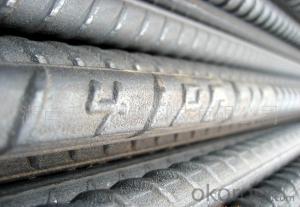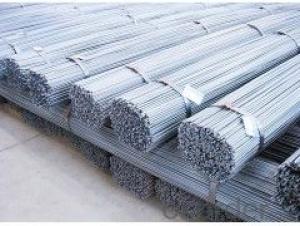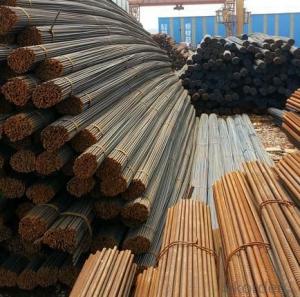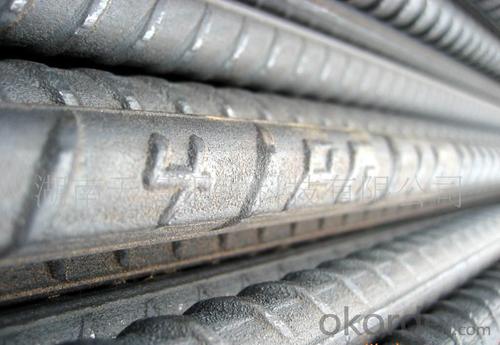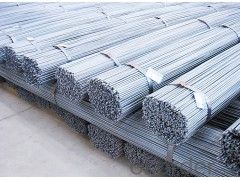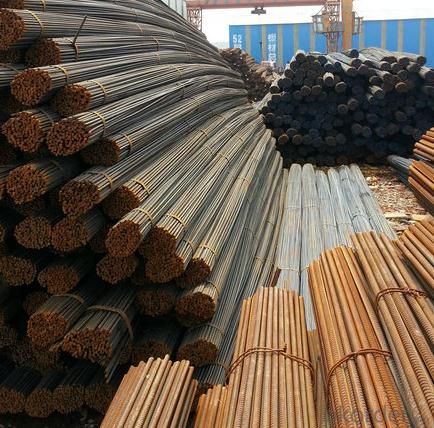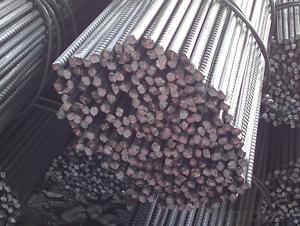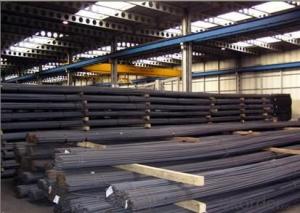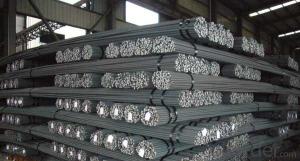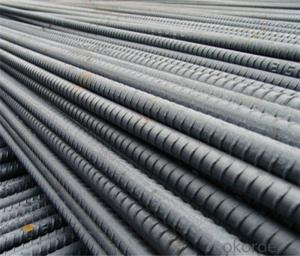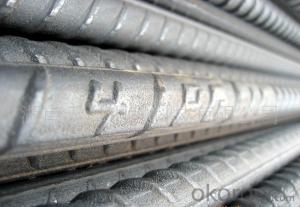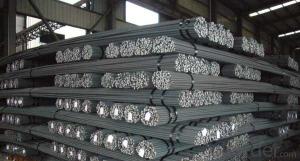A615 deformed steel bar for construction
- Loading Port:
- Tianjin
- Payment Terms:
- TT OR LC
- Min Order Qty:
- 25 m.t.
- Supply Capability:
- 10000 m.t./month
OKorder Service Pledge
OKorder Financial Service
You Might Also Like
Product Description:
Specifications of HRB500 Deformed Steel Bar:
Standard | GB | HRB500 |
Diameter | 6mm,8mm,10mm,12mm,14mm,16mm,18mm,20mm, 22mm,25mm,28mm,32mm,36mm,40mm,50mm | |
Length | 6M, 9M,12M or as required | |
Payment term | TT or L/C | |
Application | mainly used in construction industry to reinforce concrete structures and so on | |
Quality | First quality, the goods are from Chinese big manufacturers. | |
Type | Hot rolled deformed steel bar | |
Brand name | DRAGON | |
Chemical Composition: (Please kindly find our chemistry of our material based on HRB500 as below for your information)
Grade | Technical data of the original chemical composition (%) | ||||||
C | Mn | Si | S | P | V | ||
HRB500 | ≤0.25 | ≤1.60 | ≤0.80 | ≤0.045 | ≤0.045 | 0.08-0.12 | |
Physical capability | |||||||
Yield Strength (N/cm²) | Tensile Strength (N/cm²) | Elongation (%) | |||||
≥500 | ≥630 | ≥12 | |||||
Theoretical weight and section area of each diameter as below for your information:
Diameter(mm) | Section area (mm²) | Mass(kg/m) | Weight of 12m bar(kg) |
6 | 28.27 | 0.222 | 2.664 |
8 | 50.27 | 0.395 | 4.74 |
10 | 78.54 | 0.617 | 7.404 |
12 | 113.1 | 0.888 | 10.656 |
14 | 153.9 | 1.21 | 14.52 |
16 | 201.1 | 1.58 | 18.96 |
18 | 254.5 | 2.00 | 24 |
20 | 314.2 | 2.47 | 29.64 |
22 | 380.1 | 2.98 | 35.76 |
25 | 490.9 | 3.85 | 46.2 |
28 | 615.8 | 4.83 | 57.96 |
32 | 804.2 | 6.31 | 75.72 |
36 | 1018 | 7.99 | 98.88 |
40 | 1257 | 9.87 | 118.44 |
50 | 1964 | 15.42 | 185.04 |
Usage and Applications of HRB500 Deformed Steel Bar:
Deformed bar is widely used in buildings, bridges, roads and other engineering construction. Big to highways, railways, bridges, culverts, tunnels, public facilities such as flood control, dam, small to housing construction, beam, column, wall and the foundation of the plate, deformed bar is an integral structure material. With the development of world economy and the vigorous development of infrastructure construction, real estate, the demand for deformed bar will be larger and larger..
Packaging & Delivery of HRB500 Deformed Steel Bar:
Packaging Detail: products are packed in bundle and then shipped by container or bulk vessel, deformed bar is usually naked strapping delivery, when storing, please pay attention to moisture proof. The performance of rust will produce adverse effect.
Each bundle weight: 2-3MT, or as required
Delivery Detail: within 45 days after received advanced payment or LC.
Label: to be specified by customer, generally, each bundle has 1-2 labels
Trade terms: FOB, CFR, CIF
Deformed Steel Bar in stock
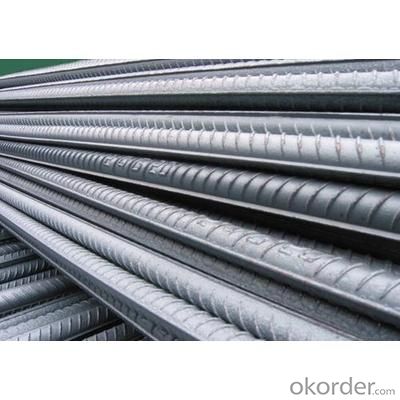
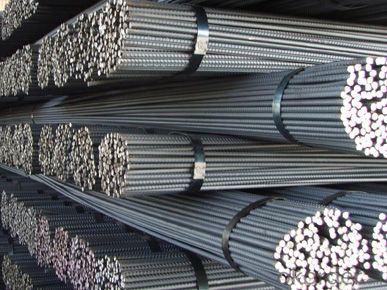
Deformed Steel Bar in testing
Note:
1. Our products are produced according to national standard (GB), if not, supply according to national standards (GB) or agreement as customer required.
2. Other Grade and Standard Deformed Steel Bar we can supply:
Grade: GR40/GR60, G460B/B500A/B500B/B500C,BST500S
Standard: ASTM, BS, DIN
The Minimum Order Quantity of these products is high, and need to be confirmed.
3. We can not only supply Deformed Steel Bar; if you need anything about building materials, please contact us for further information.
4. Please send us your detail specifications when inquire. We will reply to you as soon as possible. We sincerely hope we can establish a long stable business relationship.
- Q: How are steel rebars stored on site to prevent damage?
- Steel rebars are typically stored on site in a way that prevents damage by keeping them off the ground, away from moisture, and organized to avoid any bending or deformation. This can be achieved by using racks or pallets to elevate the rebars, covering them with tarps or plastic sheets to shield from rain or snow, and arranging them in a neat and orderly manner to minimize any accidental mishandling or impact.
- Q: What are the factors that determine the selection of steel rebars?
- The factors that determine the selection of steel rebars include the required strength and durability, the specific application and load requirements, the environmental conditions such as exposure to corrosion or high temperatures, the cost-effectiveness, and compliance with relevant building codes and regulations.
- Q: Can steel rebars be galvanized for added protection?
- Yes, steel rebars can be galvanized for added protection. Galvanizing is a process where a thin layer of zinc is applied to the surface of the steel rebar. This zinc coating acts as a sacrificial layer that provides protection against corrosion. It forms a barrier between the steel and the environment, preventing moisture and other corrosive elements from reaching the surface of the rebar. Galvanized steel rebars are commonly used in construction projects, particularly in areas where corrosion is a concern, such as coastal regions or environments with high humidity. The galvanizing process enhances the longevity and durability of the steel rebar, making it resistant to rust and corrosion.
- Q: What is the recommended spacing between steel rebars in concrete slabs?
- The recommended spacing between steel rebars in concrete slabs typically ranges from 12 to 18 inches, depending on the size and thickness of the slab.
- Q: What is the process of joining steel rebars together?
- The process of joining steel rebars together is commonly done through methods such as overlap splicing, mechanical splicing, and welding. In overlap splicing, two rebars are overlapped and tied together using wire or steel straps. Mechanical splicing involves using couplers or threaded connectors to join rebars together. Welding, on the other hand, involves melting the ends of two rebars and fusing them together using heat. Each method has its own advantages and considerations, depending on factors like the structural requirements and project specifications.
- Q: What is the difference between three - grade steel and other grades?
- Three rebar is the new standard name for HRB400 steel, three steel for the old, as a kind of hot rolled ribbed bar. In construction, three - grade rebar is called the past.
- Q: What are the guidelines for cutting and bending steel rebars on-site?
- The guidelines for cutting and bending steel rebars on-site typically include using appropriate tools such as a rebar cutter and bender, ensuring safety measures such as wearing protective gear, following the required dimensions and angles specified in the construction plans, and using proper techniques to achieve clean and accurate cuts and bends. It is crucial to follow local building codes, manufacturer's instructions, and industry best practices to ensure structural integrity and worker safety.
- Q: How do steel rebars affect the overall flexibility of concrete structures?
- Concrete structures are greatly improved by the addition of steel rebars. These rebars increase the tensile strength of concrete, making it more resistant to cracking and deformation when under load. Concrete is strong when compressed, but weak when pulled. By incorporating steel rebars into the concrete, it creates a composite material that combines the strength of concrete with the strength of steel. The rebars act as reinforcement by distributing the load across the structure and preventing the concrete from failing when pulled. This reinforcement helps to limit the formation and spread of cracks, as the rebars bear the stress and prevent the concrete from completely separating. As a result, the presence of rebars significantly enhances the flexibility and ductility of the concrete structure, allowing it to withstand different forces and movements without catastrophic failure. Furthermore, steel rebars also improve the stability of concrete elements. They provide additional strength and support, preventing excessive deflection, bending, or buckling of the structure. This ensures that the structure can withstand external loads and environmental conditions. The increased flexibility and stability contribute to the durability and longevity of the concrete structure, making it more resistant to factors such as seismic activity, temperature changes, and shrinkage. In conclusion, steel rebars are essential in enhancing the overall flexibility of concrete structures. They provide the necessary tensile strength to counteract the weakness of concrete in tension, preventing cracking and deformation. By reinforcing the structure, steel rebars improve its stability, durability, and ability to withstand various forces and movements, ensuring the integrity and longevity of the concrete elements.
- Q: How are steel rebars connected or joined together during construction?
- Steel rebars are typically connected or joined together during construction by overlapping the ends of the rebars and tying them using steel wire or using mechanical couplers.
- Q: How are steel rebars installed in concrete?
- Steel rebars are installed in concrete by first placing them in the desired locations within the concrete formwork. The rebars are then secured in place using wire ties or rebar chairs to ensure they remain in the correct position during the pouring and curing process. This helps to reinforce the concrete and provide strength to the structure.
Send your message to us
A615 deformed steel bar for construction
- Loading Port:
- Tianjin
- Payment Terms:
- TT OR LC
- Min Order Qty:
- 25 m.t.
- Supply Capability:
- 10000 m.t./month
OKorder Service Pledge
OKorder Financial Service
Similar products
Hot products
Hot Searches
Related keywords
